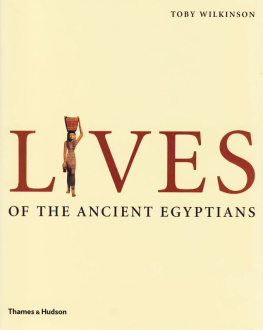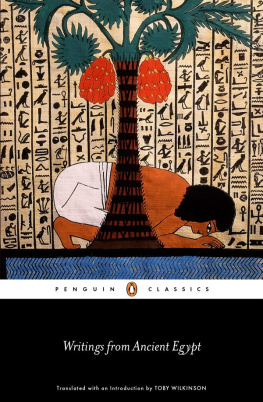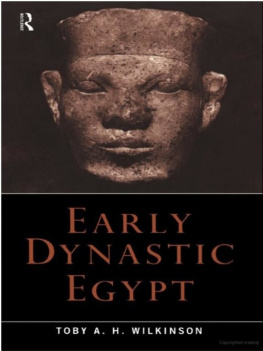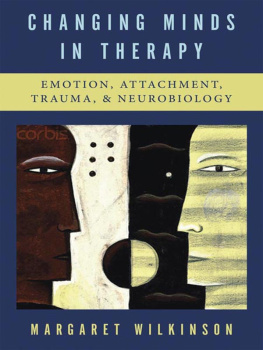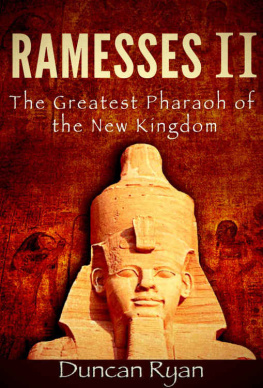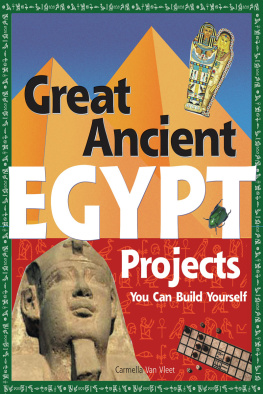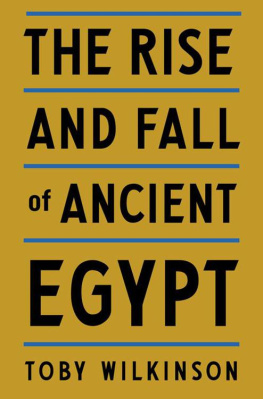About the Author
Toby Wilkinson holds a doctorate in Egyptology from the University of Cambridge where he is a Fellow of Clare College. He lectures widely on ancient Egypt and has extensive experience of the archaeological sites in the Nile Valley and Egyptian deserts. His other publications include Early Dynastic Egypt, Genesis of the Pharaohs and The Thames & Hudson Dictionary of Ancient Egypt.
Authors Note
Particular thanks are due to Dr Aidan Dodson, Dr Bill Manley and Peter Grose-Hodge who kindly read earlier drafts of this book and made a number of helpful corrections, comments and suggestions. The author would also like to thank Professor Geoffrey Martin for supplying a key study on the life and career of Maya; Dr David Denisch for material relating to the career of Hesira; the editorial and production staff at Thames & Hudson for their enthusiasm and support; and Michael Bailey, as always, for his patience and understanding.
The intention of this book is to enable the reader to explore and experience the history and civilization of the ancient Nile Valley through the lives of its inhabitants. To maintain the pace and flow of the narrative, and with a general readership in mind, the writing deliberately eschews the caveats that properly characterize academic studies of ancient Egyptian material. It must be acknowledged, however, that our picture of pharaonic civilization is both partial and fragmentary. The lives that follow comprise a mix of established fact, scholarly consensus and educated guesswork but, we trust, more of the first two and relatively little of the last. Readers interested in finding out more about the individual life-stories, and the debates that continue to surround them, are referred to the suggestions for further reading at the end of the book.
Originally published in the United Kingdom in 2007 as
Lives of the Ancient Egyptians
ISBN 978-0-500-05148-1
by Thames & Hudson Ltd, 181a High Holborn, London WC1V 7QX
and in the United States of America by
Thames & Hudson Inc., 500 Fifth Avenue, New York, New York 10110
Copyright 2007 Thames & Hudson Ltd, London
This electronic version first published in 2013 by
Thames & Hudson Ltd, 181a High Holborn, London WC1V 7QX
This electronic version first published in 2013 in the United States of America by
Thames & Hudson Inc., 500 Fifth Avenue, New York, New York 10110.
To find out about all our publications, please visit
www.thamesandhudson.com
www.thamesandhudsonusa.com
All Rights Reserved. No part of this publication may be reproduced or transmitted in any form or by any means, electronic or mechanical, including photocopy, recording or any other information storage and retrieval system, without prior permission in writing from the publisher.
ISBN 978-0-500-77162-4
ISBN for USA only 978-0-500-77163-1
On the cover: Statuette of an offering bearer found in the Tomb of Meketra,
Thebes, 11th Dynasty, Metropolitan Museum of Art, New York.
Who is the first ancient Egyptian known to us by name? The origins of hieroglyphic writing have now been pushed back, beyond the beginning of the 1st Dynasty, into an era when Egypt was still a collection of competing kingdoms, not yet unified into a single nation-state. There are combinations of signs from this early period which may be names, but we cannot be sure, and in any case they are difficult to read. The rulers of Egypts predynastic period must, for the moment, remain anonymous. The first king whose name is readable, and consistently written on objects ranging from simple sherds of pottery to a decorated stone mace-head, belongs at the very start of the dynastic sequence. His most famous artifact, a ceremonial palette from the temple at Hierakonpolis (ancient Nekhen), stands in the entrance hall of the Egyptian Museum in Cairo, welcoming visitors at the start of their tour through 3,000 years of pharaonic culture. It has become an icon of the foundation of a great civilization; the king for whom it was made is recognized as the first in Egyptian history.
His name is Narmer except that the reading Narmer is almost certainly wrong. The two signs used to write the name, a catfish and a chisel, did indeed have the phonetic values nar and mer in later phases of hieroglyphic writing, but there are compelling reasons to think that they represented different sounds at this early period. Indeed, the name Narmer may not be a name at all, rather, a combination of symbols associating the king with the fierce forces of nature (catfish) and their striking power (chisel). As such, it would belong within the dominant mode of expression found in prehistoric royal iconography. This explanation of Narmers name would support his identification as a transitional figure, whose reign spanned the predynastic past and the dynastic future, whose lasting achievement was to recast the ideology and iconography of royal power into new, lasting forms that would endure for the next three millennia.
What do we know about Narmer the man? He became king around 3000 BC and was almost certainly from the Upper Egyptian city of This (ancient Tjeni, near modern Girga); this was one of the early centres of Egyptian civilization and the capital of a kingdom which, by the closing years of the predynastic period, encompassed the northern part of Upper Egypt, most of Middle Egypt and parts of the Delta. Whether by diplomacy or force, Narmer extended his rule over the whole of Egypt, from the First Cataract to the fringes of the Delta. A key step in this process of territorial consolidation may have been Narmers marriage to a woman named Neithhotep. Judging from the location of her tomb, she was descended from the old royal family of Nagada (ancient Nubt), one of Thiss rival centres in Upper Egypt which it may have conquered some years earlier. A strategic alliance between these two royal families would have been a good basis for building a wider political consensus. In this same vein, Narmer took pains to venerate the shrine of Horus at Hierakonpolis, the third major centre of Upper Egyptian power. Horus was not only the citys local god, but was also the god of kingship. So paying homage to his cult served the dual purpose of reinforcing Narmers royal credentials while satisfying the elite of Hierakonpolis that their new ruler, if not a local man, intended to respect their traditions.
The two most impressive objects donated by Narmer to the temple of Horus were consummate examples of royal iconography, and powerful statements about the extent of royal power. The ceremonial macehead showed the king, enthroned beneath a canopy, watching a parade of prisoners and tribute, and observing rituals associated with the two localities Buto (ancient Djebaut) in the northwestern Delta and Hierakonpolis itself in southern Upper Egypt that symbolized the geographical extremes of his new realm. The decorated palette carried scenes of a similarly symbolic nature: the king smiting a bound captive, inspecting ranks of slain and decapitated enemies, tearing down the walls of a rebel stronghold. Whether the enemy was intended to represent a Delta chieftain or a foreign tribesman, the message was the same and crystal clear: as king of all Egypt, Narmer would brook no opposition. He would defend Egypts borders, but the quid pro quo was the unswerving loyalty of the entire populace. This uncompromising message was reinforced at Egypts southern frontier by the construction of a massive fortress on the island of Elephantine (ancient Abu) which both guarded the river approach from Nubia and towered over the local community. The authoritarian character of divine kingship had already been firmly established.
The xenophobia of state propaganda on a cylinder seal from Hierakonpolis, Narmer is shown beating a group of Libyans, while an ivory fragment from his tomb shows a bearded Asiatic stooping in homage to the king masked a more pragmatic attitude to foreign relations. The discovery of Egyptian pottery from the reign of Narmer at sites throughout the northern Delta and southern Palestine suggests active trade between the two regions. The royal court went to great lengths to obtain the valuable commodities it required to maintain its economic and political dominance. A series of inscriptions carved on an isolated rock outcrop in the heart of Egypts eastern desert bear witness to an expedition sent by Narmer to this remote region, probably in search of gold or high-quality stone.
Next page
